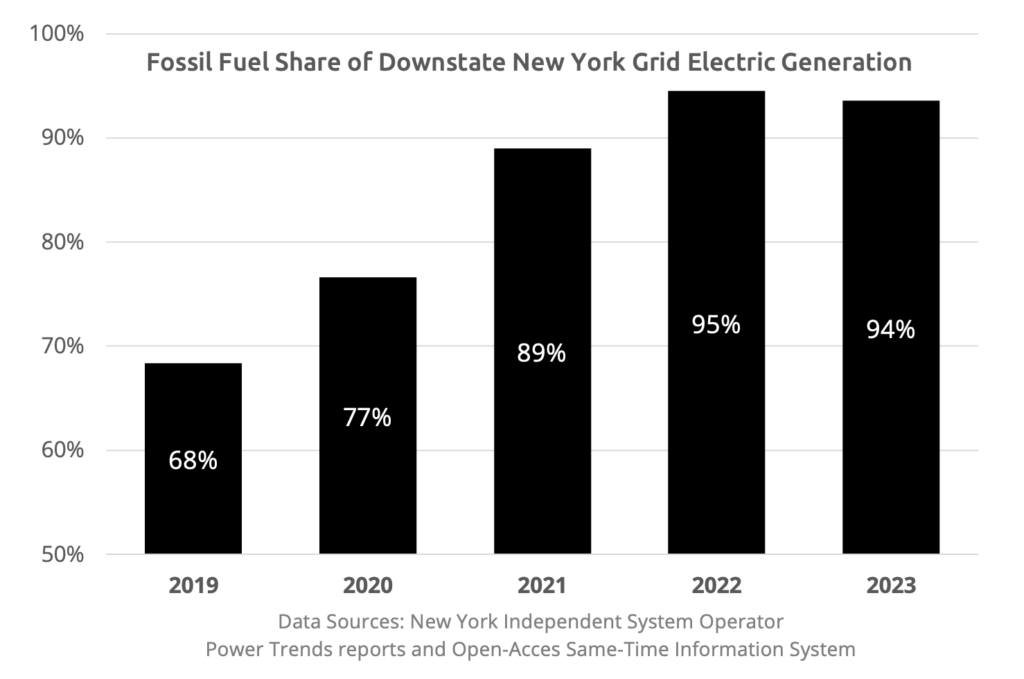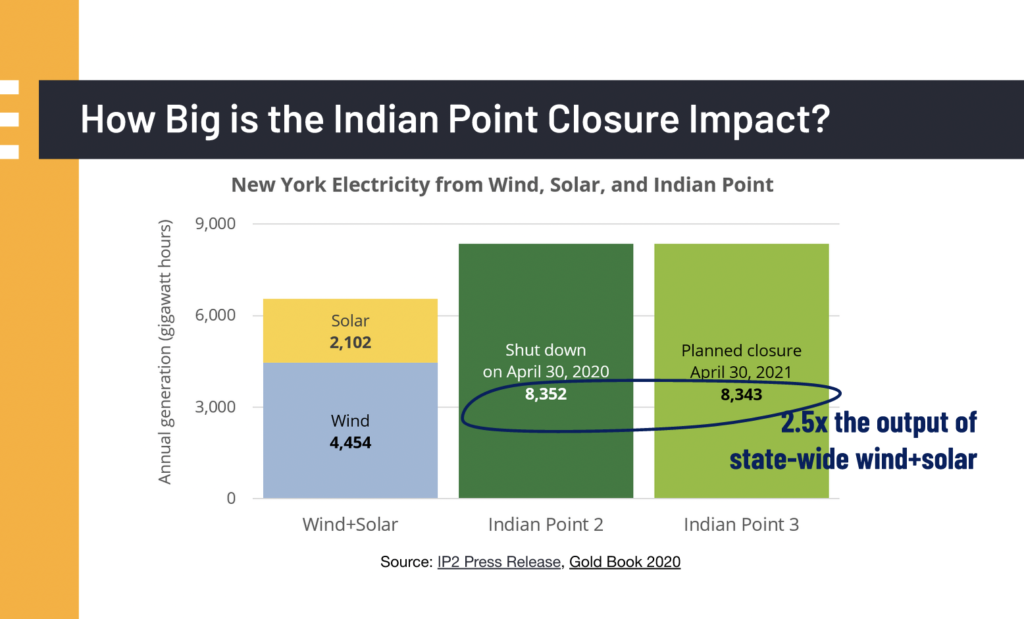Last updated February 2025.
Indian Point was the largest energy source New York State for years, reliably providing over 80% of the metro New York City area’s carbon-free electricity. It directly employed 1,000 workers in multi-generational well-paying positions, and indirectly generated much more economic activity benefiting local communities.
The atomic age for New York’s electricity began on September 16, 1962, with the operation of Indian Point 1, a 275 megawatt (MW) boiling water reactor. Indian Point 1 shut down in 1974 for economic and regulatory reasons. By that time, however, the 1,032 MW Pressurized Water Reactor Indian Point 2 was already operational. The 1,051 MW Indian Point 3 Pressurized Water Reactor entered operation less than two years later.
When fossil gas prices were low, the Cuomo administration and vocal anti-nuclear groups colluded to shutter this carbon-free energy source, claiming that renewable energy and efficiency would replaced it. In reality, it was a massive market share transfer to gas combustion, subsequently made clear by electricity regulator New York Independent Systems Operator (NYISO). Nuclear New York and many others correctly predicted this outcome and appealed to all elected officials to prevent this impending disaster. None even responded, let alone acted to prevent this industrial sabotage. Consequently, since passage of the Climate Leadership and Community Protection Act (CLCPA), New York has increased fossil pollution from the electricity sector by a third. New York City electricity prices are up, along with gas prices. The city is also substantially more vulnerable to energy shortages during the hottest months of the year.
We urge New York to learn the right lessons from the wanton loss of Indian Point. Nuclear energy provides well-paying jobs, steady tax revenues, stable communities, and ample amounts of reliable electricity for a prosperous society. Carbon-free nuclear power means energy security, clean air, and environmental justice.

Source: New York Independent System Operator Power Trends and Gold Book Reports
Industrial Sabotage and Energy Insecurity

Nuclear energy operates off cheap uranium and skilled labor, the largest component of its costs. Indian Point provided high-paying, largely unionized jobs for 1,000 women and men. These multi-generational jobs and tax revenues enabled a vibrant, healthy, and prosperous community. In contrast, the new fossil plants employ about 51 people in total. At the plant’s closure ceremony in April 2021, Nuclear New York and allies created a public art demonstration with a thousand yellow hats, each hat representing a clean energy job eliminated.
“We oppose taking zero-carbon nuclear power facilities offline. Shutting down Indian Point had devastating, long-term consequences to the state’s power supply and the economy that are irreversible. Thousands of union jobs were lost and not replaced. We cannot make this mistake again,” said James Shillitto, President of the Utility Workers Union of America Local 1-2. “As the state looks to the future, we urge a balanced approach to meet our carbon reduction commitments while delivering affordable electricity, bolstering infrastructure, improving grid reliability, and creating New York jobs that support families and communities.”
“New York is serving itself a one-two punch of energy insecurity in winter,” said Meredith Angwin, the author of the bestselling book ‘Shorting the Grid.’ “New York is replacing Indian Point with power plants that depend on just-in-time imported gas. Gas for power production is in high demand and tight supply in winter because home heating needs have first priority on the gas. The risk of gas supply disruption is greatest on the coldest days. And the recently approved Champlain Hudson Power Express project also fails to guarantee electricity for New York in winter. When it is really cold, supplier Hydro Quebec reserves all its electricity for Quebecoise customers. For energy security, New York needs to increase its energy independence from imported gas and imported electricity. But New York is doing just the opposite.”
Closure of Indian Point threatens the reliability of the electric grid serving downstate New York, leading to higher power costs and potential energy shortages. New York City is at extremely elevated risk to emergencies, as observed by NYISO (2021-2030 Comprehensive Reliability Plan).
Climate Impact
With the Indian Point closure, transmission-congested Downstate New York’s grid electric generation went from 68% fossil powered in 2019 to 94% in 2023.

The CLCPA’s goals include carbon-free electricity by 2040. However, the closure of Indian Point caused annual greenhouse gas emissions of New York’s electric sector to increase by 12-15 million CO2-equivalent metric tons, nearly a third.

Two massive fossil combustion plants, Cricket Valley Energy Center and CPV Valley Energy Center, came online to take the place of Indian Point’s steady, 2,080 MW power, as forewarned by NYISO. To this day, CPV’s plant operates without proper emissions permits.
“It’s perplexing, indeed, disturbing that a plant of the magnitude of CPV is operating without a Title V Clean Air Act permit.” said Wawayanda resident Madeline Shaw of Protect Orange County, a group opposing their community from becoming a ‘sacrifice zone.’
New York’s Climate Action Council completed a Scoping Plan on how the state should comply with the CLCPA. Extending the life of New York’s remaining nuclear plants to 80 years benefits New Yorkers to the tune of $9 billion. Based on this estimate, shutting Indian Point robbed New Yorkers over $16 billion.
In April 2022, Dr. Dietmar Detering of Nuclear New York: “We knew that pollution would go up with the loss of Indian Point. However, this winter the 1,100 MW Cricket Valley Energy Center barely generated any electricity at all. Generation had to shift to out-of-state and inner-city power plants—when rates were already high from elevated gas prices. The result: Record high electricity prices in the Capital region and downstate. Shutting down Indian Point truly was a lose-lose decision for climate, communities, and ratepayers, though some generators certainly made a lot of money this winter!”
Said Dr. James E. Hansen, climate scientist and former director of NASA’s Goddard Institute, “Tackling the climate crisis requires policies based on facts, not prejudice. Wind and solar power help with early decarbonization, where they can replace fossil fuels without need for large storage and transmission upgrades. However, systems overly dependent on intermittent, low-energy-density renewables—as California and Germany have proven—lead to skyrocketing electric rates, grid instability, and continued dependence on fossil fuels.”
Magnitude

Indian Point, the state’s largest power generation asset, produced 2.5x the amount of carbon-free energy that all the in-state solar panels and wind turbines did in 2019.

Air Pollution Impacts
Burning fossil fuels also generates other harmful pollutants, like particulate matter. Fine particulates – especially those with a diameter smaller than 2.5 microns (PM2.5) – are particularly dangerous to the human respiratory system, as they deplete lung capacity.
The closure of the Indian Point Energy Center, a significant source of clean energy for New York City, requires New York City customers to rely more heavily on the aging, heavily polluting in-City fossil generation fleet. This increased reliance has the potential to negatively impact local air quality, thereby exacerbating public health issues that already exist in disadvantaged communities in and around New York City, such as high incidences of asthma and other respiratory ailments.
New York City’s filings in the NYS Clean Energy Standard docket (15-E-0302)
“How many African American children should suffer from asthma in order to marginally improve the level of fish egg mortality in the Hudson River?” –African American Environmentalist Organization

Regulated nuclear power is the safest source of energy worldwide, and the Indian Point generators operated safely for 54 years. Risks of an extremely low-probability nuclear accident need to be balanced against documented health effects associated with outdoor air pollution, including to respiratory illnesses like Covid-19.
The agreement between New York State, Entergy (the plant’s former owner), and Riverkeeper (a local antinuclear group) to close Indian Point was signed in early 2017 without public notice or participation. Despite former Governor Cuomo’s assurance at the time that replacement power will have “no new carbon emissions,” reality has proven otherwise.
Low-Carbon Alternatives
Transmission bottlenecks limit emission-free electricity from reaching Downstate New York.

Opposition to transmission projects limits upstate wind power from reaching population-dense, renewable-starved downstate NY, where solar and wind provide only 2% of electricity. The proposed transmission lines would bring hydro from Quebec and wind from upstate New York, however their combined output does not come close to that of Indian Point.
Notes
Combined Cycle Gas Turbines generate 758-932 gCO2-eq/kWh at 2.3%-3.5% methane leak rates. Displacing 16.3 TWh of nuclear generation (12 gCO2-eq/kWh) with gas-fired electricity increases annual GWP20 emissions by 12.2-15.0 million tonnes (Mt) CO2e. Methane is a 84x-worse pollutant than CO2 over a 20-year time horizon (GWP20). New York’s CLCPA defined CO2 equivalencies for other greenhouse gases over 20 years, a time-frame appropriate for addressing the urgency of climate change.
New York denied the Zero Emissions Credits for Indian Point, which allowed upstate nuclear plants to compete with shale economics.
